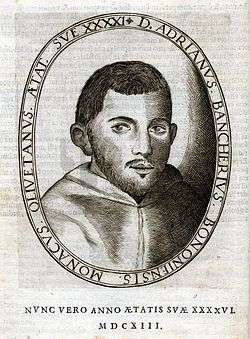Adriano Banchieri

Adriano Banchieri (Bologna, 3 September 1568 – Bologna, 1634) was an Italian composer, music theorist, organist and poet of the late Renaissance and early Baroque eras. He founded the Accademia dei Floridi in Bologna.[1]
Biography
He was born and died in Bologna (then in the Papal States). In 1587 he became a monk of the Benedictine order, taking his vows in 1590, and changing his name to Adriano (from Tommaso). One of his teachers at the monastery was Gioseffo Guami, who had a strong influence on his style.
Like Orazio Vecchi he was interested in converting the madrigal to dramatic purposes.[1] Specifically, he was one of the developers of a form called "madrigal comedy" — unstaged but dramatic collections of madrigals which, when sung consecutively, told a story. Formerly, madrigal comedy was considered to be one of the important precursors to opera, but most music scholars now see it as a separate development, part of a general interest in Italy at the time in creating musico-dramatic forms. In addition, he was an important composer of canzonettas, a lighter and hugely popular alternative to the madrigal in the late 16th century. Banchieri disapproved of the monodists with all their revolutionary harmonic tendencies, about which he expressed himself vigorously in his Moderna Practica Musicale (1613), while systematizing the legitimate use of the monodic art of figured bass.[1]
In several editions beginning in 1605 (reprinted at least six times before 1638), Banchieri published a series of organ works entitled l'Organo suonarino.[2]
Banchieri's last publication was the Trattenimenti da villa of 1630.[3] According to Martha Farahat[3] he wrote five madrigal comedies between 1598 and 1628 with "plot and character development", starting with La pazzia senile of 1598, the last of them La saviezza giovenile.
Works
Secular vocal works
- 1593 Primo libro dei Madrigali a 5 voci (Milano 1593)
- 1597 I Libro delle canzonette a 3 voci: Hora prima di ricreazione, Venezia 1597;
- 1598 II Libro delle canzonette a 3 voci: La pazzia senile. Ragionamenti vaghi et dilettevoli, Venezia 1598;
- 1600 III Libro delle canzonette a 3 voci: Il studio dilettevole a 3 voci, nuovamente con vaghi argomenti et spassevoli intermedii fiorito nell'Amfiparnasso commedia musicale dell'Honoratio Vecchi Milano 1600;
- 1601 IV Libro delle canzonette a 3 voci : Il Metamorfosi musicale, Venezia 1601;
- 1607 V Libro delle canzonette a 3 voci : Virtuoso ridotto tra signori e dame entr' il quale si concentra recitabilmente in suoni e canti una nuova commedia detta prudenza giovanile... op.15, Milano 1607, poi ristampato come Saviezza giovanile, Venezia 1628;
- 1614 VI Libro delle canzonette a 3 voci: Tirsi, Fili e Clori che in verde prato di varianti fiori cantano il Sesto libro delle canzonette a 3 voci Venezia 1614).
- 1604 Il Zabaione musicale, Invenzione boschereccia a 5 voci (Milano 1604).
- 1605 Barca di Venetia per Padova dentrovi la nuova mescolanza op.12 (Libro dei madrigali a 5 voci Venezia 1605).
- 1608 Festino della sera del giovedì grasso avanti cena op. 18 (Libro III madrigali a 5 voci Venezia 1608).
- 1622 Vivezze di Flora e Primavera cantate recitate e concertate con 5 voci, nello spinetto o chitarrone op. 44 (Libro V madrigali a 5 voci Venezia 1622).
- 1626 Il virtuoso ritrovo accademico del Dissonante, publicamente praticato con varianti concerti musicali a 1-5 voci ò stromenti nell'Accademia dei Filomusi op. 49 (Venezia 1626).
- 1625 La Sampogna musicale (Bologna 1625).
- 1628 La fida fanciulla, commedia esemplare con musicali intermedii apparenti e inapparenti (Bologna 1628).
- 1630 Trattenimenti da villa concertati in ordine seguente nel chitarrone con 5 voci in variati modi. Vaga et curiosa concatenatione drammatica (libro VI madrigali a 5 voci Venezia 1630).
References in modern culture
In 2008, a group of four composers including Lorenzo Ferrero and Bryan Johanson wrote a collaborative composition for organ and orchestra entitled Variazioni su un tema di Banchieri, which was first performed in Bologna on August 2 of that same year.
Media
 |
The Battle
Performed by Sylvia Kind on a harpsichord of the type made in the early 20th century |
| Problems playing this file? See media help. | |
References
- 1 2 3
 Chisholm, Hugh, ed. (1911). "Banchieri, Adriano". Encyclopædia Britannica (11th ed.). Cambridge University Press.
Chisholm, Hugh, ed. (1911). "Banchieri, Adriano". Encyclopædia Britannica (11th ed.). Cambridge University Press. - ↑ Bonta, Stephen (Spring 1969). "The Uses of the 'Sonata de Chiesa'". Journal of the American Musicological Society. Richmond, Va.: American Musicological Society. 22 (1): 56. ISSN 0003-0139. JSTOR 830812. doi:10.2307/830812.
- 1 2 Farahat, Martha (1991). "On the Staging of Madrigal Comedies". Early Music History. Cambridge, U.K.: Cambridge University Press. 10: 123–143. ISSN 0261-1279. JSTOR 942452. OCLC 8595852. doi:10.1017/S026112790000111X. Farahat's article concerns itself with the consensus among scholars that Banchieri's madrigal comedies were not intended to be staged but only for concert use, and some evidence that they were so intended; and a few related questions.
Sources
- Cinzia Zotti, Le Sourire du moine: Adriano Banchieri da Bologna; Musicien, homme de lettres, pédagogue, équilibriste sur le fil des querelles du Seicento, Serre Éditeur, Nice, 2008.
External links
| Wikimedia Commons has media related to Adriano Banchieri. |
- Adriano Banchieri, biographie de CInzia Zotti.www.noblessedelasne.org
- Free scores by Adriano Banchieri in the Choral Public Domain Library (ChoralWiki)
- Free scores by Adriano Banchieri at the International Music Score Library Project (IMSLP)
- The Mutopia Project has compositions by Adriano Banchieri
- Contraponto bestiale alla mente (PDF - original version at classicaland.com)
- Original texts of Bertoldino and Caccasenno